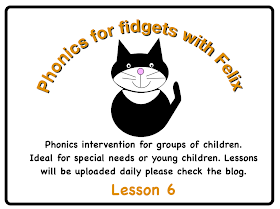Learning objective:
To read/write grapheme/phoneme /e/ and segment and blend cvc wordsRevisit/review:
Play clap rap - 'Clap clap turn around, I'll show you a letter and you'll tell me its sound'Get the children to clap with you and to actually turn around. Show them the letter, can they tell you the sound?
'Clap clap think and frown, I'll tell you a letter and you'll write it down'
Give each child a whiteboard for this so that they can write some of the letters they have learnt so far. (I do believe it is important to have the same emphasis on reading as well as writing. We often end up with children who can read better than they can write).
Teach:
| Teach /e/ using objects beginning with /e/ This is an eeeeegg, this is an eeeelephant, this is eeeempty Please click here for a set of phase 2 grapheme cards. Use the Jolly phonics action. Pretend to tap an egg on the side of a pan and crack it into the pan, saying eh, eh, eh All the children to do the action and say the sound. Make sure each child is saying the sound correctly. Skywrite the letter /e/ You could also get children to sit in a circle and write the sound on each other's back so they can really feel it. Click here to download a little booklet for letter formation. Practise:
Play Bingo
You can either ask the children to draw a cross on their whiteboard and write their own words in or download the sheet below and write the words in and copy as many times as you need. I have deliberately included some adjacent consonant words. Lots of people teach this in phase 4 but I do believe that children can usually manage at this stage especially with the adjacent consonant at the end. Try your children and read the list with them first. If you have children who just cannot manage this then change the words for other words which include /e/ Use the following words
If using whiteboards write the list on a board. Children must choose 4 words to write on their board.
When they have done this - encourage them to do it quickly then begin playing bingo. You can either hide the board and just read out in random order or write the words on flashcards.
Apply:
Reading captions
Download the following captions and ask the child to read and draw a picture of their caption. They must read it themselves by blending each word and thinking about the meaning of the caption. DOWNLOAD Captions Send Home:
A list of words to practice with a parent. The aim being fast blending to automacy.
Please click here for the list of words.
Lessons will be added daily so to find all of the lessons either click the label 'planning' in the side bar or click here.
|




















